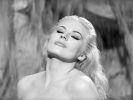Eye For Film >> Movies >> Becoming Anita Ekberg (2014) Film Review
Becoming Anita Ekberg
Reviewed by: Rebecca Naughten

In 1960, the French philosopher Edgar Morin - one of the first people to consider star images as constructed symbols - wrote that certain films can transform a mere actor into something else and that while the actor and character remain separate entities, "from their union is born a composite creature who participates in both, envelopes them both: the star". Mark Rappaport's essay film considers Anita Ekberg from this perspective - the roles and films (specifically those with Frank Tashlin and Federico Fellini) that cultivated a specific image for her, transforming her from a sex symbol to a sex goddess and international film star.
From the outset, Rappaport emphasises the importance of Fellini's La Dolce Vita (1960) to Ekberg's image - a film in which she was "playing a movie star, even though she wasn't one at the time" and that made her an international star overnight - but then tracks back to a couple of earlier roles in order to underline Hollywood's conscious shaping of nascent stars, and the film industry's limitations for beautiful blondes.

For example, in one of her first major roles - alongside Dean Martin and Jerry Lewis in Tashlin's Artists and Models (1955) - she had seventh billing but was physically prominent in the opening credits and played a character named Anita. Rappaport asks whether this latter point was a stroke of luck or if the character was named after her in the hope of making 'Anita' into a more recognisable commodity. In her subsequent film with Tashlin - Hollywood Or Bust (1956), another Martin and Lewis film - she had been promoted in the billing and was now playing a fictional movie star named 'Anita Ekberg'. Although she is "still required to display her wares" in the opening credits, the film is effectively "a 90-minute commercial hawking Anita Ekberg".
But even with her name above the title, Hollywood gave her limited scope onscreen. She had to return to Europe for her role of a lifetime - just 20 minutes in Fellini's three-hour film gave her screen immortality. But sex goddess status doesn't guarantee you interesting roles or prolong your stardom - "the ugly truth about being beautiful is that it can't last forever" - and by Rappaport's argument, it was Fellini who best utilised (and played with) what "Anita Ekberg" connoted. Obviously interested in depicting the behind-the-scenes aspects and meta-narratives of filmmaking, the Italian director worked with Ekberg two further times, in Boccaccio '70 (1962) - in which she plays a giant version of herself, a billboard image come to life - and Intervista (1987), which reunited her with Marcello Mastroianni on camera for them rewatch the La Dolce Vita's Trevi Fountain sequence some 27 years after it was filmed. To see the two of them together again - with the passage of time evident on their bodies and faces - is immensely moving.
Becoming Anita Ekberg highlights that stardom is crystallised through a handful of definitive moments, and successfully argues that some stars become forever fixed in specific images (many of which are publicity images rather than actual film stills). The film is a fascinating and humorous exploration of a star image and its use by savvier directors.
Reviewed on: 12 Oct 2015
















